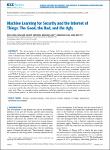Item Infomation

| Title: | Machine Learning for Security and the Internet of Things: The Good, the Bad, and the Ugly |
| Authors: | Liang, F. |
| Participants: | Hatcher, W. G. Liao, W. Gao, W. Yu, W. |
| Issue Date: | 2019 |
| Publisher: | IEEE Xplore |
| Series/Report no.: | IEEE Access, (2019), Vol 7, pp 158126-158147 |
| Abstract: | The advancement of the Internet of Things (IoT) has allowed for unprecedented data collection, automation, and remote sensing and actuation, transforming autonomous systems and bringing smart command and control into numerous cyber physical systems (CPS) that our daily lives depend on. Simultaneously, dramatic improvements in machine learning and deep neural network architectures have enabled unprecedented analytical capabilities, which we see in increasingly common applications and production technologies, such as self-driving vehicles and intelligent mobile applications. Predictably, these technologies have seen rapid adoption, which has left many implementations vulnerable to threats unforeseen or undefended against. Moreover, such technologies can be used by malicious actors, and the potential for cyber threats, attacks, intrusions, and obfuscation that are only just being considered, applied, and countered. In this paper, we consider the good, the bad, and the ugly use of machine learning for cybersecurity and CPS/IoT. In detail, we consider the numerous bene ts (good use) that machine learning has brought, both in general, and speci cally for security and CPS/IoT, such as the improvement of intrusion detection mechanisms and decision accuracy in CPS/IoT. More pressing, we consider the vulnerabilities of machine learning (bad use) from the perspectives of security and CPS/IoT, including the ways in which machine learning systems can be compromised, misled, and subverted at all stages of the machine learning life-cycle (data collection, pre-processing, training, validation, implementation, etc.). Finally, the most concerning, a growing trend has been the utilization of machine learning in the execution of cyberattacks and intrusions (ugly use). Thus, we consider existing mechanisms with the potential to improve target acquisition and existing threat patterns, as well as those that can enable novel attacks yet to be seen. |
| URI: | http://tailieuso.tlu.edu.vn/handle/DHTL/9864 |
| Appears in Collections: | Tài liệu hỗ trợ nghiên cứu khoa học |
ABSTRACTS VIEWS
19
VIEWS & DOWNLOAD
6
Files in This Item:
Bạn đọc là cán bộ, giáo viên, sinh viên của Trường Đại học Thuỷ Lợi cần đăng nhập để Xem trực tuyến/Tải về
Items in DSpace are protected by copyright, with all rights reserved, unless otherwise indicated.
